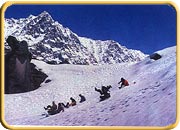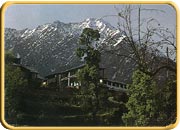Kangra
Kangra
 Kangra
Valley is one of the most picturesque valley of lower Himalyas. The valley,
sheltered by the sublime Dhauladhar range, is green and luxuriant. It provides
a tremendous contrast in nature of places to be visited. Dharamshala is full
of Buddhist air whereas ancient Hindu Temples like Brajeshwari, Baijnath, Jawalamukhi
and Chamunda Devi dot the country side.
Kangra
Valley is one of the most picturesque valley of lower Himalyas. The valley,
sheltered by the sublime Dhauladhar range, is green and luxuriant. It provides
a tremendous contrast in nature of places to be visited. Dharamshala is full
of Buddhist air whereas ancient Hindu Temples like Brajeshwari, Baijnath, Jawalamukhi
and Chamunda Devi dot the country side.The history of Kangra valley dates back to the Vedic times more than 3500 yrs. ago. The area was exposed to successive invasions, the last being the British domination over the princes of the hill states. Despite the onslaughts and political upheavels, the arts and crafts of the region continued to develop and found lyrical expressions. Crafts like the exquisitely designed shawls and miniature paintings of this region are internationally appreciated. Kangra became a Mughal province, Shah Jahan captured it for his father,Emperor Jehangir. In the 18th century Raja Sansar Chand Katoch II recaptured the fort from the Mughals and extended the boundaries of Kangra into the Chamba and Kullu valleys. The flory of the valley is brought out in the invaluable and delicate Kangra painting that the Raja commissioned to express his love for a comely Gaddi maiden and the beautiful land she dwelled in. Under Raja Sansar Chand II the region prospered.

During the mid 18th century, a new style of painting developed, based on Mughal miniature painting, but with a different subject matter. The theme was derived from Radha Krishna legends and depicted the rulers and the gods in a local setting.
In 1744 - 1773 Raja Govardhan Singh of Guler gave shelter to many artists who had fled from the Mughals and thus gave birth to the famed Kangra School of Painting.
Another attraction in town is the Kangra fort which was the seat of power of the Katoch Rajas. It is said to have been founded by Susharma Chand Katoch, an ally of the Kauravas during the Mahabharata war. It was the ancient capital of the Katoch kingdom and a symbol of power in the Punjab Hill States. The fort stands on a steep rock dominating the valley and a narrow path leads up to the fort which was once protected by several gates and had the palace of the Katoch kings safely perched at the top. The Kangra fort, where the Raja held court for nearly 25 years, was adorned with paintings and attracted art lovers from great distances. About forty thousand of these paintings are preserved in temples, palaces and museums at Chamba, Chandigarh and Delhi.
The Brajeshwari Devi Temple in Kangra town, achieved a reputation for wealth in gold, pearls and diamonds and tempted many invaders over centuries. Mahmud Ghazni sacked it in 1009, Muhammed -bin-Tughlaq plundered it in 1337, Sikander Lodi destroyed the idols in the early 15th century and yet the temple was sacked again by Khawas Khan in 1540.
In the intervening years the temple was rebuilt and refurbished several times but in the great earthquake of 1905 both the temple and the fort were badly damaged. The present temple was built in 1920 and stands behind the crowded, colourful bazar.
Select a holiday with us